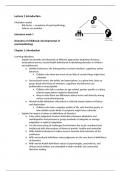Lecture 1 introduction
Mediation model:
- Risk factor -> symptoms of psychopathology
- Indirect via mediator
Literature week 1
Disorders of childhood: developmental of
psychopathology
Chapter 1: introduction
Learning objectives:
- Explain the benefits and drawback of different approaches (statistical deviance,
sociocultural norma, mental health definitions) to identifying disorders in children
and adolescents
o Statistical deviance: the infrequently of certain emotions, cognitions and/or
behaviors
Children who show too much of too little of certain things might have
a disorder
o Sociocultural norms: the beliefs and expectations, in a given time, place or
group about what kinds of emotions, cognitions and behaviors are
problematic or unacceptable
Children who fail to conform to age-related, gender specific or culture
relevant expectations might be disordered
Keep in mind there are differences about norms and diversity among
various sociocultural groups
o Mental health definitions: theoretical or clinically based notions of distress
and dysfunction
Children who have a negative quality of life, who function poorly, or
who exhibit certain kinds of symptoms might have a disorder
- Explain the impact of values on definitions of disorders
o A key value judgement involves distinctions between adaptation and
maladaptation and personal or group standards of adequate or average
adaptation or optimal adaptation
o It is the overcoming of challenges that furnishes the social, emotional and
intellectual skills that produce all forms of growth, healthy and unhealthy
o With statistical deviance it makes sense to examine both extremes of the
continuum
o With sociocultural definitions value judgments are the very basis of definitions
of disorders
o With mental health definitions values of psychologists, psychiatrists, and
clinical social workers are embedded in both scientific and community
decisions making
,- Discuss the implications of the definition of developmental psychopathology that
includes descriptions of typical and atypical patterns of emotion, cognition and
behavior
o Psychopathology: intense, frequent, and/or persistent maladaptive patterns of
emotion, cognition and behavior
o Developmental psychopathology extends this description to emphasize that
these maladaptive patterns occur in the context of typical development and
result in the current and penitential impairments of infants, children and
adolescents
- Identify several goals related to research on rates of disorders in children and
adolescents
o Estimating rates of disorders:
Identifying children with clinically significant distress and dysfunction,
whether or not they are in treatment
Calculating levels of general categories of disorders and within-
category type of disorder and their associated impairments
Tracking changing trends in the identification and diagnosis of specific
disorders (autism, ADHD and depression)
o Developmental epidemiology: frequencies and patterns of disorders
Prevalence: proportion of a population with a disorder (random
sampling)
Incidence: the rate at which new cases arises in a given time period
- Discuss several factors that influence current estimates of rates of disorders
o Increased rates of disorders:
Increased help-seeking by children, parents and others
More screening and better recognition of disorders
Changes related to individual vulnerability, family life and widespread
sociocultural change and challenge
- Outline several issues related to the allocation of resources, availability of treatments
and access to care
o Children aged 12-17 years were more likely to have received mental health
care than children age 5-11 years
o White children were also more likely to receive mental health treatment
o Boys more likely
o Rural (platteland) were more likely to receive medication treatment
o Lack of everyday availability of mental health treatments
- Outline barriers to care and ways in which barriers are experienced by children and
families of various backgrounds
o Barriers related to the structure and funding of the mental health care system:
Limited or poorly-conceived mental health policies
Lack of provider availability
Long waiting lists
Lack of service coordination
Inconveniently located services
Transportation difficulties
Inability to pay and/or inadequate insurance coverage
o Barriers related to perceptions about mental health services:
, Lack of trust in the system
Previous negative experiences
Stigma related to seeking help
o Language barriers, cultural barriers
o Stigmatization
- Summarize the important information provided by global perspectives of children’s
mental health and mental illnesses
o Rapid social change, urbanization and urban poverty and inadequate health
and educational services are key factors that increase children’s vulnerability
to psychopathology
o Interventions:
Prevention efforts and treatment for those with various disorders
o Holistic approaches with achievable goals, embedded in health, social and
educational networks have been proposed
o The development and implementation of globally useful interventions require
recognition of the current disconnect between where research takes place
and where the need is greatest
Chapter 2: models of child development, psychopathology, and treatment
Learning objectives:
- Explain the difference between dimensional models of psychopathology and
categorical models of psychopathology
o Dimensional models: the ways in which typical feeling, thoughts, and
behaviors gradually become more serious problems, which then may intensify
and become clinically diagnosable disorders
Continuous or quantitative
Typical difficulties
o Categorical models: emphasize discrete and qualitative differences in
individual patterns of emotion, cognition and behavior.
Clear distinctions in what is normal and what is not
Discontinuous or qualitative
Problems of a different sort altogether
- Summarize the key assumptions and contributions of each model of development,
disorder and treatment
o Physiological models: there is a physiological (genetic), structural, biological
and/or chemical basis for all psychological processes and events
Connectome: the diagram of the brain’s neural connections
All physiological systems interact with one another, adapting to the
environments in which the child develops
o Psychodynamic models:
The impact of unconscious processes on typical and atypical
personality development
Conflicts among processes and structures of the mind
Stages of development with different ages associated with distinctive
emotional, intellectual and social challenges
, The lasting impact of more successful resolutions of stage-related
challenges on later outcomes
o Contemporary psychodynamic approaches continue to emphasize:
Unconscious cognitive, affective and motivational processes
Mental representations of self, other and relationships
The meaningfulness of individual experiences
A developmental perspective focused on the origins of typical and
atypical personality in early childhood and the constantly changing
psychological challenges faced by children as they age
o Mentalizing: the capacity to understand others and oneself in terms of
internal mental states
o Behavioral models: outward orientation, focusing on the individual’s
observable behavior within specific environments
Conditioning and reinforcement
o Cognitive models: components and processes of the mind
o Humanistic and positive psychology models:
Humanistic models: emphasize meaningful experiences, innate
motivations for healthy growth, and the child’s purposeful creation of
self
Positive psychology: increasing emphasis on the positive subjective
experiences, positive individual traits, and positive institutions that
promote individual, family, social and community well-being
Positive youth development: focuses on fostering healthy
development in adolescence and emphasize youth strengths,
the plasticity of development and resilience
o Family models: the best way to understand the personality and
psychopathology of particular children is to understand the dynamics of their
particular families
Families have a special impact on typical and atypical development
because they are the first setting for children’s experiences
Shared environment: the aspects of family life and function that are
shared by all children in the family, often contrasted with genetic
variables
Nonshared environment: the aspects of family life and function that
are specific and distinct for each child
Differences in sibling experiences and outcomes
Important role peers
o Sociocultural models: relevant cultural factors
Key assumptions:
Children develop within the social arrangements of a given
moment
These arrangements are changed by events and trends
Developing individuals change history
Cultures make sense of the ways of development
Birth cohort: individuals born in a particular historical period who
share key experiences and events (social media, war, pandemic)






